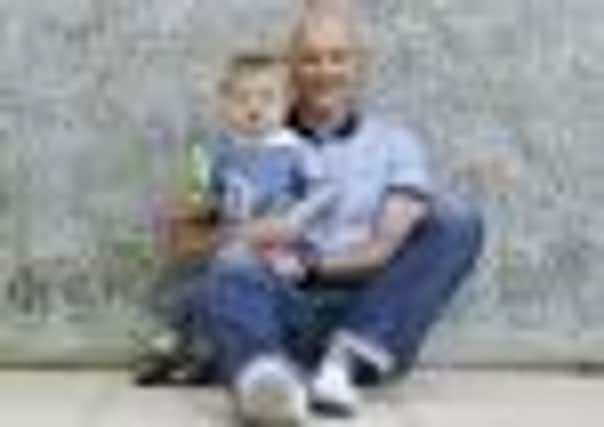Health: ‘I can’t even play five-a-sides any more’


IT took a few days for the life-changing consequences of his diagnosis to sink in.
Dalkeith Thistle stalwart Barrie Richardson couldn’t hide his shock as an orthopaedic surgeon at the Royal Infirmary explained why he had been struggling to play football for the previous five months – a sport he had revelled in since the age of eight.
Advertisement
Hide AdAdvertisement
Hide AdIn February this year, at the age of 33, he became one of more than eight million people across the UK to have been diagnosed with osteoarthritis (OA) – a condition that forced him to hang up his boots after a 12-year career in junior football.


“I was in shock for a few days,” Barrie, who lives in Bonnyrigg, recalled. “You don’t really expect to get that kind of thing at a young age. It was a case of trying to understand what the condition was and its consequences.
“The surgeon said I had to stop playing football and if I didn’t, I would have to get surgery asap.
“Because football was something I had played since I was young, it was hard to give it up, but I was coming to the tail end of my career which maybe made it slightly easier. There are still times when I wish I could go back and play, but I can’t even play five-a-sides any more.”
Barrie of course is not alone in having his sporting career ended by OA, as marathon legend Paula Radcliffe’s Olympic dreams were shattered this month after losing her own battle with the condition at the age of 38. A recent report by the charity Arthritis Care found that while the average age of OA diagnosis is 57, as many as one in five people under 45 also suffer from the condition.
A major factor in Radcliffe’s condition was the repetitive foot stress caused by long-distance running. She described the joint in her left foot as “degenerative and badly damaged”.
Consultant rheumatologist, Professor Simon Bowman, said: “Although we call osteoarthritis wear-and-tear arthritis, for most people it isn’t necessarily related to the activities they’ve done.
“But athletes are putting so much stress on their joints, and someone like Paula Radcliffe would be more prone to arthritic problems because she’s an elite athlete.”
Advertisement
Hide AdAdvertisement
Hide AdOA is the most common form of arthritis, and the survey, OANation 2012, found that 71 per cent of people with OA are in constant pain, with one in eight – more than a million people – saying the pain is often “unbearable”.
OA occurs when the cartilage which covers joint surfaces and normally cushions movement is worn thin, leading to friction and pain.
It can occur in any joint, but is most common in the hips, knees and hands. Pain and stiffness are the most common symptoms of OA, and sometimes extra bone can be formed round the joints, further restricting normal movement. There may also be secondary inflammation, causing swelling.
But OA is much more complex than just simple wear and tear, and has both environmental and genetic causes.
Arthritis Research UK estimates that around 50 per cent of the risk of developing the condition is due to inherited genetic factors.
Last month, a separate study identified eight new genetic regions linked to the disease, in areas involving cell maintenance, regulation of cartilage, bone development and body weight.
It is hoped that the findings may eventually help researchers develop drugs to stop the disease.
Meanwhile, Professor Bowman warned that OA is becoming more common, with the OANation survey predicting that cases are set to double to more than 17 million by 2030. The huge expected rise is because two of the main risk factors for developing the disease – being overweight and over 50 – are anticipated to increase massively over the next 20 years.
Advertisement
Hide AdAdvertisement
Hide Ad“While there’s nothing we can do about ageing, we can manage our diet and weight and minimise the stress on our joints,” said Judith Brodie, chief executive of Arthritis Care. “There’s evidence that exercise delays the onset of osteoarthritis. That first step of movement if you’re in pain can be really difficult, but it’s worth it. If you get moving and keep moving, it can make a big difference.”
Barrie, who was diagnosed with the condition in his left hip, is following experts’ advice, replacing football and running with swimming, cycling and going to the gym. He is determined to remain active for his 18-month-old son Cal.
“It’s a forced lifestyle change; I can’t do impact sports at all now,” he said.
“I’m trying to make sure every day is as pain free as possible – there’s ups and downs.” The project manager for National Services Scotland at The Gyle added: “I’d love to get to my early 40s before I need a hip replacement, but I just don’t know when I will need one – it’s a lottery to be honest.
“The surgeon said you can have a maximum of two hip replacements in a lifetime – the first replacement lasts around 15 to 20 years and the second one ten years, so you don’t want to get a replacement until later in life.”
The father-of-one, who was at the Arniston Rangers club for most of his career and also had spells at Edinburgh United and East Seniors outfit Whitehill Welfare, urged those with similar symptoms not to ignore them and to visit a doctor instead without delay.
“I had stiffness and pain in my abductor muscle since last September but I tended to ignore it.
“I thought it was because I was over 30 and it was just aches and pains. I thought it was just a case of age catching up on me.”